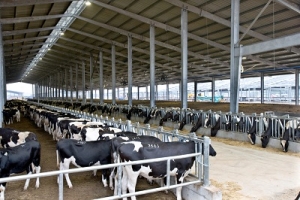 Farms come in all shapes and sizes, and anyone who has spent time in agriculture knows that big farms are not bad farms. In fact, the way a farm is managed and the way animals are cared for is completely independent of the size of the farm. Nevertheless, the American consumer has fallen victim to the “big is bad” mentality, and farms are no exception.
Farms come in all shapes and sizes, and anyone who has spent time in agriculture knows that big farms are not bad farms. In fact, the way a farm is managed and the way animals are cared for is completely independent of the size of the farm. Nevertheless, the American consumer has fallen victim to the “big is bad” mentality, and farms are no exception.
About 97% of the 47,000 dairy farms in the U.S. are family-owned. While the vast majority of U.S. farms milk less than 200 cows, 86% of the milk is produced on farms with more than 100 cows. Larger farms are able to capture the benefits of economies of scale, but what does that mean for the cow?
A recent study published in the Journal of Dairy Science investigated the link between animal welfare risks and farm size. The study was conducted in Australia, where the majority of herds are pasture based, but the takehome messages should apply for farms with any management style. The researchers surveyed 863 dairy farmers with farm sizes ranging from less than 150 milking cows to over 700.
The study concluded that stocking density and the number of cows per full time employee equivalent were higher on the larger farms. However, 97% of employees on farms milking between 501 and 700 cows had formal degrees in dairy management or had participated in industry training courses. Only 44% of the employees on farms milking less than 150 cows had industry training or qualifications.
The incidence of lameness and mastitis were completely independent of herd size, and in all cases were well below 10%. Larger farms reported a lower incidence of milk fever, indigestion, and down cows compared to smaller farms. In addition, larger farms worked more closely with their veterinarian, fed specialized diets to their fresh cows, and were more likely to separate sick cows from the main herd for specialized care.
The operators of farms of all sizes agreed that it’s important to identify sick cows and quickly provide treatment. Many larger farms incorporated automated technologies into their management, such as parlor RFID or activity monitoring systems, to efficiently identify when cows need additional attention. The reported behavior and friendliness of the cows was not different between farm sizes, and in fact, over 90% of farmers reported that the cows are friendly towards people and are content most of the time.
The most effective strategy to debunk the “big farms are bad” mentality is to share your personal stories and experiences with farms of all sizes. Story sharing should be done in a way that connects with the consumer based on shared values, such as your compassion for your animals or your love of the outdoors. However, this research provides scientific evidence that supports the claim that animals are well cared for on all farms, no matter the size.
Source: Miner Institute









